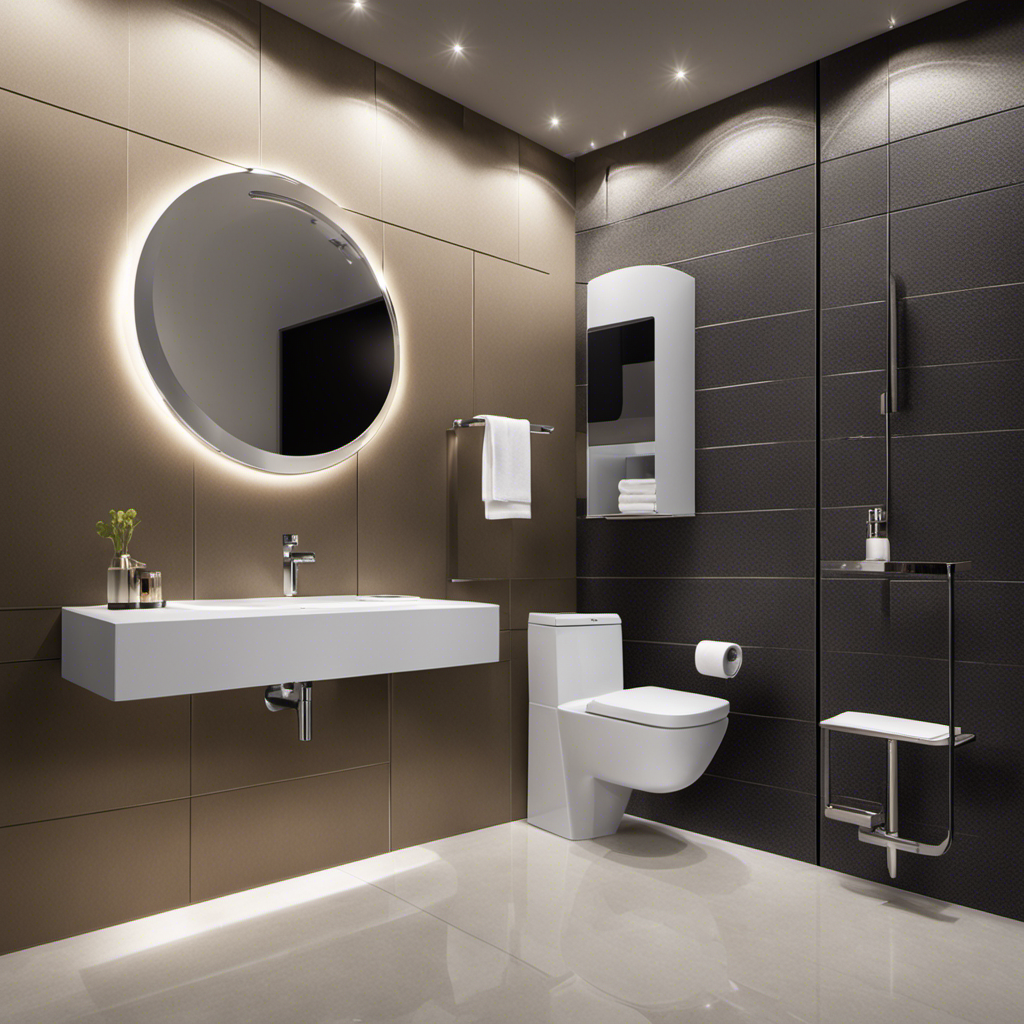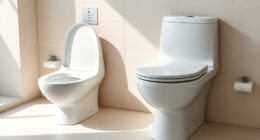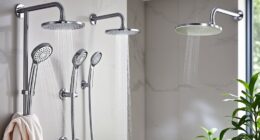I know what you’re thinking – does it really matter where you mount your toilet paper holder? Well, let me tell you, it does.
Finding the ideal height, considering the location and accessibility, and choosing the right mounting surface are all crucial factors to ensure a seamless bathroom experience.
In this article, I will guide you through the ins and outs of where to mount your toilet paper holder, providing you with expert tips and tricks for a hassle-free installation.
So, let’s dive in and make sure your toilet paper is always within reach.
Key Takeaways
- Install the toilet paper holder at a height of around 26 inches from the floor to ensure easy accessibility and convenience.
- Choose a location easily accessible from the toilet seat and consider the available wall space in the bathroom.
- Take into account the aesthetics of the bathroom and select a design that complements the decor.
- Ensure proper distance from other fixtures and leave enough clearance between the holder and adjacent fixtures.
Determining the Ideal Height
Determining the ideal height for the toilet paper holder can be tricky. When considering the ergonomic aspects, it is important to ensure that the holder is easily accessible and convenient to use. The height should be such that it allows for a comfortable reach without straining or stretching. A good rule of thumb is to install the holder at a height of around 26 inches from the floor. This ensures that it is within easy reach for most individuals, including children and people with disabilities.
In addition to the ergonomic considerations, there are also decorative options to consider. The height of the toilet paper holder can be adjusted to complement the overall aesthetics of the bathroom. It can be placed at a height that is visually pleasing and harmonizes with the other fixtures. This allows for a cohesive and well-designed bathroom space.
Whether you prefer a modern or traditional look, the height of the toilet paper holder can play a significant role in enhancing the overall ambiance of the bathroom. By carefully considering both the ergonomic and decorative aspects, you can determine the ideal height for your toilet paper holder.
Consider the Location and Accessibility
When considering where to place the toilet paper holder, it’s important to think about the location and how easily accessible it will be. This decision will depend on whether you prefer a decorative or functional design, as well as whether you want a freestanding or wall-mounted holder.
Here are some key factors to consider:
-
Style: Choose a design that complements your bathroom decor. There are a wide range of options available, from sleek and modern to ornate and traditional.
-
Convenience: Ensure that the toilet paper holder is within easy reach from the toilet. It should be placed at a comfortable height for all users.
-
Space: Consider the available wall space in your bathroom. If you have limited space, a wall-mounted holder would be a great space-saving option.
-
Installation: Freestanding holders are easy to install as they require no drilling. Wall-mounted holders may require some DIY skills or professional installation.
-
Durability: Select a holder made from durable materials that can withstand moisture and frequent use.
Considering these factors will help you make an informed decision about the location and accessibility of your toilet paper holder.
Now let’s move on to the next step – choosing the right mounting surface.
Choosing the Right Mounting Surface
Once you’ve considered the style and space available, it’s important to choose a suitable surface for your toilet paper holder.
When it comes to toilet paper holders, there are two main options to consider: decorative versus practical. Decorative holders often come in unique designs and materials, adding a touch of style to your bathroom. On the other hand, practical holders prioritize functionality and ease of use.
If you prefer a freestanding option, there are alternatives to the traditional wall-mounted holders. Freestanding holders offer flexibility in terms of placement and can be easily moved around if needed. They come in various styles, such as floor stands or countertop models, allowing you to choose the best option for your bathroom layout.
Remember to consider both the aesthetics and functionality of your toilet paper holder when selecting the right surface. Whether you opt for a decorative or practical option, or choose a freestanding alternative, ensure that it complements your bathroom decor and meets your needs.
Ensuring Proper Distance From Other Fixtures
To ensure proper distance from other fixtures, it’s important to consider the layout and dimensions of your bathroom. This not only ensures functionality but also maintains hygiene standards. Here are some key points to consider when determining the placement of your toilet paper holder:
- Accessibility: Choose a location that is easily accessible from the toilet seat, ensuring convenience for users.
- Wall space: Look for a spot on the wall that has enough space to accommodate the holder without interfering with other fixtures.
- Height: Install the holder at a suitable height for all users, typically around 26 inches from the floor.
- Clearance: Leave enough clearance between the holder and adjacent fixtures to prevent any interference.
- Style and type: Consider the different types of toilet paper holders available, such as wall-mounted, freestanding, or recessed, and choose one that matches the aesthetic of your bathroom.
By carefully considering these factors, you can ensure a proper and functional placement of your toilet paper holder.
Now, let’s move on to the next section for installation tips and tricks.
Installation Tips and Tricks
Now, let’s dive into some tips and tricks for installing your toilet paper holder. When it comes to DIY toilet paper holder installation, there are a few key things to keep in mind. First, consider the design of your toilet paper holder. There are various designs available, including wall-mounted, freestanding, and recessed options. Choose one that suits your bathroom decor and personal preferences. Next, ensure you have the necessary tools and materials for installation, such as screws, anchors, and a drill. Finally, follow these steps for a successful installation:
| Step | Description |
|---|---|
| 1 | Measure and mark the desired height and location for your toilet paper holder. |
| 2 | Use a level to ensure your marks are straight and even. |
| 3 | Drill pilot holes at the marked locations. |
| 4 | Attach the mounting hardware to the wall using screws and anchors. |
| 5 | Finally, attach the toilet paper holder to the mounting hardware. |
Conclusion
In conclusion, when it comes to mounting a toilet paper holder, there are several factors to consider.
Determining the ideal height is crucial for accessibility and convenience.
Additionally, choosing the right mounting surface is essential for stability and durability.
It is also important to ensure proper distance from other fixtures to avoid any inconvenience.
By following these installation tips and tricks, you can create a functional and aesthetically pleasing bathroom.
So, why settle for less when you can have a well-mounted toilet paper holder that enhances your bathroom experience?










